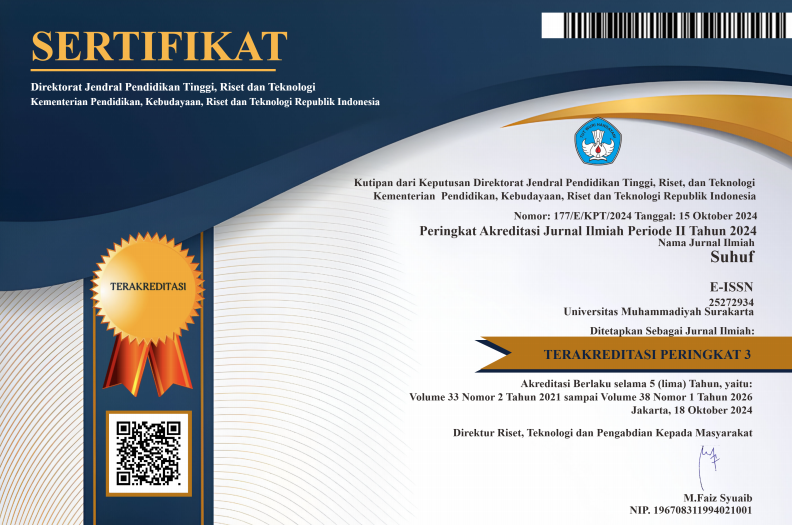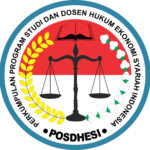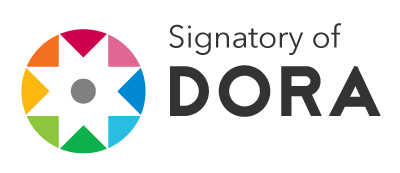ChatGPT's Validity and Reliability in Islamic Legal Studies: A Critical Assessment of Waqf for Early Learners
DOI:
https://doi.org/10.23917/suhuf.v37i2.11821Keywords:
Waqf, Islamic Law, Islamic Studies, Islamic Education, Self-Learning, Artificial intelligenceAbstract
This study evaluates the validity and reliability of ChatGPT in presenting Islamic legal knowledge on waqf, focusing on its usefulness for early learners relying on free digital tools without formal Islamic education. Conducted in Indonesia, the world’s largest Muslim-majority country, the research uses ChatGPT-3.5 in Indonesian. Data were analyzed qualitatively by comparing ChatGPT’s responses with Al-Mawsūʿah al-Fiqhiyyah al-Kuwaitiyyah, Buku Pintar Wakaf, and Buku Wakaf Kontemporer across four dimensions: basic concepts, pillars and conditions, nazir (trustee) aspects, and contemporary issues. Each was rated on a five-point scale. ChatGPT scored highest in basic concepts (validity 4.80, adequacy 4.60), followed by pillars and conditions (4.44; 4.06) and Nazir (4.23; 4.06). The lowest performance was in contemporary issues (3.57 for both). Findings indicate that ChatGPT provides an accurate foundational understanding but lacks sufficient legal depth and contextual precision for advanced study. Thus, it should serve as a supplementary learning aid, not a substitute for scholarly guidance, authoritative references, or structured Islamic education grounded in sanad.
Downloads
References
[1] S. Gulyamov, “Application of Computational Law and Artificial Intelligence Methods for Sharia Compliance Analysis of E-Waste Management Systems Based on Blockchain,” Suhuf, vol. 36, no. 1, pp. 21–32, May 2024, doi: https://www.doi.org/10.23917/suhuf.v36i1.4447.
[2] F. Yavari and N. Pilevari, “Industry revolutions development from Industry 1.0 to Industry 5.0 in manufacturing,” J. Ind. Strateg. Manag., vol. 5, no. 2, pp. 44–63, 2020, [Online]. Available: https://journals.iau.ir/article_678926_9bc31a86e2f04088ce94ace73f47ce7c.pdf
[3] B. Prasetyo and U. Trisyanti, “Revolusi industri 4.0 dan tantangan perubahan sosial,” IPTEK J. Proc. Ser., no. 5, pp. 22–27, 2018, doi: http://dx.doi.org/10.12962%2Fj23546026.y2018i5.4417.
[4] A. Biswal, “Top 24 Artificial Intelligence Applications and Uses,” Simplilearn Solutions. Accessed: Aug. 20, 2025. [Online]. Available: https://www.simplilearn.com/tutorials/artificial-intelligence-tutorial/artificial-intelligence-applications
[5] Y. K. Dwivedi et al., “Opinion Paper: ‘So what if ChatGPT wrote it?’ Multidisciplinary perspectives on opportunities, challenges and implications of generative conversational AI for research, practice and policy,” Int. J. Inf. Manage., vol. 71, p. 102642, Aug. 2023, doi: https://doi.org/10.1016/j.ijinfomgt.2023.102642.
[6] M. Imran and N. Almusharraf, “Analyzing the role of ChatGPT as a writing assistant at higher education level: A systematic review of the literature,” Contemp. Educ. Technol., vol. 15, no. 4, p. ep464, Oct. 2023, doi: https://doi.org/10.30935/cedtech/13605.
[7] L. Lingard, “Writing with ChatGPT: An Illustration of its Capacity, Limitations & Implications for Academic Writers,” Perspect. Med. Educ., vol. 12, no. 1, pp. 261–270, Jun. 2023, doi: https://doi.org/10.5334/pme.1072.
[8] M. Sallam, “ChatGPT Utility in Healthcare Education, Research, and Practice: Systematic Review on the Promising Perspectives and Valid Concerns,” Healthcare, vol. 11, no. 6, p. 887, Mar. 2023, doi: https://doi.org/10.3390/healthcare11060887.
[9] B. Lund and W. Ting, “Chatting about ChatGPT: How May AI and GPT Impact Academia and Libraries?,” SSRN Electron. J., 2023, doi: https://dx.doi.org/10.2139/ssrn.4333415.
[10] M. R. King, “A Conversation on Artificial Intelligence, Chatbots, and Plagiarism in Higher Education,” Cell. Mol. Bioeng., vol. 16, no. 1, pp. 1–2, Feb. 2023, doi: https://doi.org/10.1007/s12195-022-00754-8.
[11] C. K. Lo, “What Is the Impact of ChatGPT on Education? A Rapid Review of the Literature,” Educ. Sci., vol. 13, no. 4, p. 410, Apr. 2023, doi: https://doi.org/10.3390/educsci13040410.
[12] J. R. Lechien, G. Briganti, and L. A. Vaira, “Accuracy of ChatGPT-3.5 and -4 in providing scientific references in otolaryngology–head and neck surgery,” Eur. Arch. Oto-Rhino-Laryngology, vol. 281, no. 4, pp. 2159–2165, Apr. 2024, doi: https://doi.org/10.1007/s00405-023-08441-8.
[13] A. N. Kaftan, M. K. Hussain, and F. H. Naser, “Response accuracy of ChatGPT 3.5 Copilot and Gemini in interpreting biochemical laboratory data a pilot study,” Sci. Rep., vol. 14, no. 1, p. 8233, Apr. 2024, doi: https://doi.org/10.1038/s41598-024-58964-1.
[14] L. Alkhawaja, “Unveiling the New Frontier: ChatGPT-3 Powered Translation for Arabic-English Language Pairs,” Theory Pract. Lang. Stud., vol. 14, no. 2, pp. 347–357, Feb. 2024, doi: https://doi.org/10.17507/tpls.1402.05.
[15] B. Morath et al., “Performance and risks of ChatGPT used in drug information: an exploratory real-world analysis,” Eur. J. Hosp. Pharm., vol. 31, no. 6, pp. 491–497, Nov. 2024, doi: https://doi.org/10.1136/ejhpharm-2023-003750.
[16] F. H. N. Athief, “Sejarah Munculnya Disiplin Ilmu dalam Islam [History of the Emergence of Disciplines in Islam],” Islam. J. Ilmu-Ilmu Keislam., vol. 19, no. 02, pp. 1–15, (Indonesia), Dec. 2019, doi: https://doi.org/10.32939/islamika.v19i02.386.
[17] A. Nakissa, The Anthropology of Islamic Law. Oxford University PressNew York, 2019. doi: https://doi.org/10.1093/oso/9780190932886.001.0001.
[18] A. Abubakar Muhammad, A. Ibrahim, A. A. Yakub, H. Khan, and N. Hamzah, “The Role of Islamic Finance in Promoting Economic Justice and Financial Inclusion among Marginalised Communities,” Suhuf Int. J. Islam. Stud., vol. 37, no. 1 SE-Articles, pp. 58–68, May 2025, doi: https://www.doi.org/10.23917/suhuf.v37i1.10167.
[19] F. H. N. Athief, D. Rizki, and A. Pratwindya, “Performa Bank Wakaf Mikro Selama 2017-2021: Sebuah Studi Literatur Sistematis (Systematic Literature Review) [Performance of Micro Waqf Banks During 2017-2021: A Systematic Literature Review],” IQTISHADIA J. Ekon. Perbank. Syariah, vol. 9, no. 2, pp. 204–221, (Indonesia), Nov. 2022, doi: https://doi.org/10.19105/iqtishadia.v9i2.6727.
[20] M. S. Apriantoro, M. Muthoifin, and F. H. N. Athief, “Advancing social impact through Islamic social finance: A comprehensive bibliometric analysis,” Int. J. Adv. Appl. Sci., vol. 10, no. 11, pp. 81–89, 2023, doi: https://doi.org/10.21833/ijaas.2023.11.011.
[21] M. F. F. Baharsyah, Y. Yayuli, L. Hakim, and F. H. N. Athief, “Waqf Logo as a Productive Waqf of the Digital Age in the Perspective of Maqashid Sharia,” in Proceedings of the International Conference on Islamic and Muhammadiyah Studies (ICIMS 2022), 2022. doi: https://doi.org/10.2991/assehr.k.220708.044.
[22] F. H. N. Athief, S. Q. Imama, and Y. Yayuli, “Assessing the Implication of Law 41/2004 on Waqf Practice: A Systematic Literature Review,” in International Conference on Law, Technology, Spirituality and Society (ICOLESS), 2024, pp. 81–94. [Online]. Available: https://conferences.uin-malang.ac.id/index.php/ICOLESS/article/view/3060
[23] F. Hanif, N. Athief, L. I. Cahyaningrum, D. Rizki, and A. El Ashfahany, “The Synergy of BWM and BUMDes as an Alternative for Improving the Welfare of SME,” J. Masharif al-Syariah J. Ekon. dan Perbank. Syariah, vol. 8, no. 30, pp. 71–693, 2023, doi: https://doi.org/10.30651/jms.v8i3.20656.
[24] M. Cizakca, “The waqf, its basic operational structure and development,” INCEIF, 2014. [Online]. Available: https://www.researchgate.net/profile/Lukman-Raimi/publication/288825661_WAQF_AND_ZAKAH_AS_SOCIAL_SAFETY_NETS_FOR_POVERTY_REDUCTION_IN_NIGERIA/links/5684370408ae197583937ca1/WAQF-AND-ZAKAH-AS-SOCIAL-SAFETY-NETS-FOR-POVERTY-REDUCTION-IN-NIGERIA.pdf#page=15
[25] M. Çizakça, “From Destruction to Restoration – Islamic Waqfs in Modern Turkey and Malaysia,” Endow. Stud., vol. 2, no. 2, pp. 83–106, 2018, doi: https://doi.org/10.1163/24685968-00202001.
[26] M. Cizakca, “Towards a comparative economic history of the waqf system,” J. al-Sajarah, vol. 2, no. 2, pp. 1–28, 1997, [Online]. Available: https://d1wqtxts1xzle7.cloudfront.net/99181405/TOWARDS_A_COMPARATIVE_ECONOMIC_HISTORY_OF_THE_WAQF-libre.pdf?1677492169=&response-content-disposition=inline%3B+filename%3DTowards_a_Comparative_Economic_History_o.pdf&Expires=1762787282&Signature=KUmfUnLMAc6
[27] Rahmawati, H. Thamrin, S. Guntoro, and S. Kurnialis, “Transformasi Digital Wakaf BWI Dalam Menghimpun Wakaf Di Era Digitalisasi,” J. Tabarru’ Islam. Bank. Financ., vol. 4, no. 2, pp. 532–540, (Indonesia), Dec. 2021, doi: https://doi.org/10.25299/jtb.2021.vol4(2).8375.
[28] A. Fanani, A. W. Kuncoro, A. B. M. Husni, and E. A. Wijayanti, “The Contribution of Waqf on Poverty Alleviation through Digital Platforms: A Case of Indonesia,” Shirkah J. Econ. Bus., vol. 6, no. 2, Sep. 2021, doi: https://doi.org/10.22515/shirkah.v6i2.386.
[29] Budi Setiadi, N. Nurhasanah, and S. L. Sulistiani, “Perbandingan Efektivitas Penghimpunan Dana Wakaf Melalui Uang Berbasis Online di Global Wakaf dan Dompet Dhuafa [Comparison of the Effectiveness of Collecting Waqf Funds Through Online-Based Money in Global Waqf and Dompet Dhuafa],” J. Ris. Ekon. Syariah, vol. 1, no. 1, pp. 34–38, Jul. 2021, doi: https://doi.org/10.29313/jres.v1i1.97.
[30] N. H. Laili, K. F. Khairi, and R. Masruki, “The Role of Blockchain Technology in the Management of Waqf,” in Digitalisation: Opportunities and Challenges for Business, 2023, pp. 72–81. doi: https://doi.org/10.1007/978-3-031-26953-0_9.
[31] N. M. Hj. Mohaiyadin, A. Aman, M. R. Palil, and S. Muhamad Said, “Addressing Accountability And Transparency Challenges In Waqf Management Using Blockchain Technology,” J. Islam. Monet. Econ. Financ., vol. 8, pp. 53–80, Dec. 2022, doi: https://doi.org/10.21098/jimf.v8i0.1413.
[32] W. M. B. Wan Ismail, M. S. Bin Abdul Rasool, and A. H. Bin Mohd Noor, “Technology Acceptance and Technology Usage: Importance to Cash Waqf Contribution,” Int. J. Acad. Res. Bus. Soc. Sci., vol. 11, no. 9, pp. 942–953, Sep. 2021, doi: http://dx.doi.org/10.6007/IJARBSS/v11-i9/11082.
[33] F. Niswah, L. Mutmainah, F. Hadyantari, N. Nurwahidin, and N. Huda, Do Indonesian Muslims have intention to participate on cash waqf through Fintech? 2020. [Online]. Available: https://books.google.co.id/books?hl=en&lr=&id=yMhdEAAAQBAJ&oi=fnd&pg=PA97&dq=F.+Niswah,+L.+L.+Mutmainah,+F.+Hadyantari,+N.+Nurwahidin,+and+N.+Huda,+“Do+Indonesian+Muslims+have+intention+to+participate+on+cash+waqf+through+Fintech%3F,”+in+ICSGS+2019,+2020,
[34] H. Zakariyah, A. O. Salaudeen, A. H. A. Othman, and R. Rosman, “The determinants of financial technology adoption amongst Malaysian waqf institutions,” Int. J. Soc. Econ., vol. 50, no. 9, pp. 1302–1322, Aug. 2023, doi: https://doi.org/10.1108/IJSE-04-2022-0264.
[35] J. W. Creswell and C. N. Poth, Qualitative inquiry and research design: Choosing among five approaches. Sage publications, 2016. [Online]. Available: https://books.google.co.id/books?hl=en&lr=&id=DLbBDQAAQBAJ&oi=fnd&pg=PP1&dq=J.+W.+Creswell+and+C.+N.+Poth,+Qualitative+inquiry+and+research+design:+Choosing+among+five+approaches.+Sage+publications,+2016.&ots=-it29dKQPy&sig=-patw8yNUq7BrHMFKsiMS29WiMU&red
[36] M. Bengtsson, “How to plan and perform a qualitative study using content analysis,” NursingPlus Open, vol. 2, pp. 8–14, 2016, doi: https://doi.org/10.1016/j.npls.2016.01.001.
[37] P. Burnard, “Interpreting text: an alternative to some current forms of textual analysis in qualitative research,” Soc. Sci. Heal., vol. 1, no. 4, pp. 236–245, 1995, [Online]. Available: https://www.researchgate.net/publication/313535558_Interpreting_text_an_alternative_to_some_current_forms_of_textual_analysis_in_qualitative_research
[38] K. Krippendorff, Content analysis: An introduction to its methodology. Sage publications, 2018. [Online]. Available: https://books.google.co.id/books?hl=en&lr=&id=nE1aDwAAQBAJ&oi=fnd&pg=PP1&dq=%09K.+Krippendorff,+Content+analysis:+An+introduction+to+its+methodology.+Sage+publications,+2018.&ots=y_dg-tkPeC&sig=7I89cmR5yIAIQeZ8oK6CKCqnhG8&redir_esc=y#v=onepage&q=K. Krippe
[39] M. Ridwan, “Wakaf Dan Pembangunan Ekonomi [Waqf and Economic Development],” ZISWAF J. Zakat dan Wakaf, vol. 4, no. 1, pp. 105–124, (Indonesia), 2018, doi: https://doi.org/10.21043/ziswaf.v4i1.3034.
[40] D. D. Susetyo and D. Suheni, “Proyek Percontohan Pemberdayaan Ekonomi Umat Melalui Wakaf Produktif Di Era Khalifah Usman Bin Affan [Pilot Project for Economic Empowerment of the Ummah through Productive Waqf in the Era of Caliph Usman Bin Affan],” Al-Muamalat J. Huk. Dan Ekon. Syariah, vol. 7, no. 1, pp. 67–79, (Indonesia), 2022, [Online]. Available: https://garuda.kemdiktisaintek.go.id/documents/detail/2864711
[41] J. Abdullah, “Tata Cara Dan Pengelolaan Wakaf Uang Di Indonesia [The Role of the Government in Waqf Legislation],” ZISWAF J. Zakat dan Wakaf, vol. 4, no. 1, pp. 87–104, (Indonesia), 2018, doi: https://doi.org/10.21043/ziswaf.v4i1.3033.
[42] A. Kasdi, “Peran Pemerintah Dalam Regulasi Perundang-Undangan Wakaf [The Role of the Government in Waqf Legislation],” ZISWAF J. Zakat Dan Wakaf, vol. 2, no. 2, pp. 362–379, (Indonesia), 2015, doi: http://dx.doi.org/10.21043/ziswaf.v2i2.1557.
[43] M. Ismail Abdel Mohsin, “Financing through cash-waqf: a revitalization to finance different needs,” Int. J. Islam. Middle East. Financ. Manag., vol. 6, no. 4, pp. 304–321, Nov. 2013, doi: https://doi.org/10.1108/IMEFM-08-2013-0094.
[44] A. Fanani and M. Abduh, “Discussion on Cash Waqf: Perpetuity, Legal Aspect, and Scheme of Investment Between Madzahib and Islamic Scholars,” Al-Iktisab J. Islam. Econ. Law, vol. 7, no. 1, pp. 113–140, Aug. 2023, doi: https://doi.org/10.21111/aliktisab.v7i1.10154.
[45] Muhammad Hamid and Syamsul Bakri, “Urgensi Sanad dalam Meningkatkan Profesionalitas Guru Pendidikan Agama Islam [The Urgency of Sanad in Improving the Professionalism of Islamic Religious Education Teachers],” Indones. J. Islam. Educ. Stud., vol. 1, no. 2, p. (Indonesia), Jul. 2023, doi: https://doi.org/10.61227/injuries.v1i2.18.
[46] Wahono, N. Imsiyah, and A. Setiawan, “Andragogi: paradigma pembelajaran orang dewasa pada era literasi digital [Andragogi: the paradigm of adult learning in the era of digital literacy],” in Jurnal Proceeding Universitas Muhammadiyah Surabaya, 2020, pp. 517–527, (Indonesia). [Online]. Available: https://journal.um-surabaya.ac.id/Pro/article/view/4877
[47] F. H. N. Athief, L. Hakim, I. Rosyadi, and A. Rofiqo, “Ending the Debate of Islamic Law Permissibility of Digital Wallet Through the Lens of Fiqh Adaptation.,” Manchester J. Transnatl. Islam. Law Pract., vol. 19, no. 3, 2023, [Online]. Available: https://openurl.ebsco.com/EPDB%3Agcd%3A12%3A21645548/detailv2?sid=ebsco%3Aplink%3Ascholar&id=ebsco%3Agcd%3A174026165&crl=c&link_origin=scholar.google.com
[48] I. Rosyadi, F. H. N. Athief, and D. Rizki, “Islamic Solution on the Agricultural Land Leasing Problem: Case of Excessive Time Dispute,” J. Ilm. Al-Syir’ah, vol. 20, no. 2, p. 139, Aug. 2022, doi: https://doi.org/10.30984/jis.v20i2.1679.
[49] F. C. Windiastuti and F. H. N. Athief, “Inacoin Cryptocurrency Analysis: An Islamic Law Perspective,” J. Islam. Econ. Laws, vol. 2, no. 2, pp. 152–177, 2019, doi: https://doi.org/10.23917/jisel.v2i2.8585.
Downloads
Submitted
Accepted
Published
How to Cite
Issue
Section
License
Copyright (c) 2025 Neng Fitri Hedi Susanti, Hendri Tanjung, Trisiladi Supriyanto , Fauzul Hanif Noor Athief, Aminullah Furqoni

This work is licensed under a Creative Commons Attribution 4.0 International License.


















